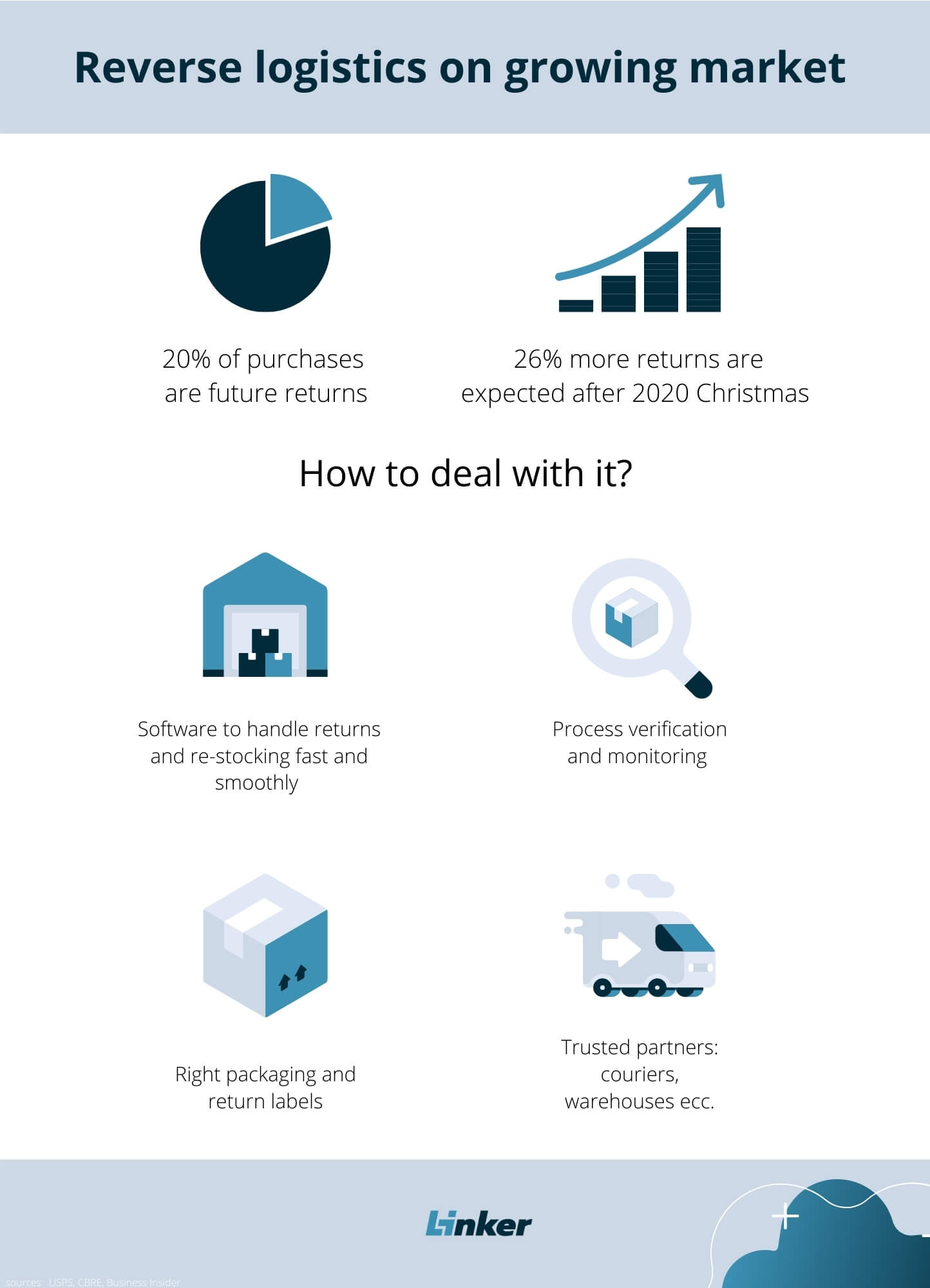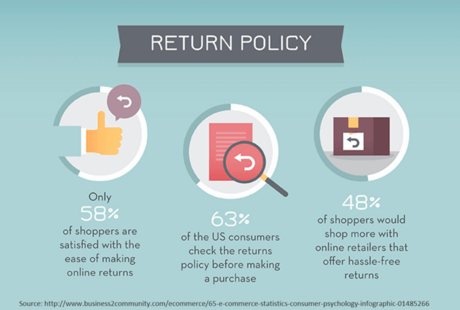In order to answer your request, we are obligated to process the data given above. Sometimes, however, we would like to use them for slightly different purposes, such as statistical data or informing you about our new products and services.We promise that we will use the given information for communication purposes only. We also remind you that you can unsubscribe from our mailing at any time (see Privacy Policy).
Returns management in ecommerce may be a pain for many online sellers. Even if an ecommerce business notices an increase in their sales, it usually casts a shadow on overall happiness, as the number of returns is growing as well. For many ecommerce businesses, it's one of the most difficult and painful processes, because of its logistic complexity, cost generation, and a feeling of having given up your earnings.
Of course, it's not only an issue of the online store, but there's no denying that online purchases have greater return rates than brick-and-mortar stores, and there are good reasons for this, such as when visiting a physical shop, there is no question about the product size, receiving the incorrect goods. In-store purchases are more precise and preceded by a verified decision-making process, while for online shoppers it's often buying a pig in a poke.
Is it possible to manage ecommerce returns in a way it isn't your pain point anymore, or even transform it into an advantage? In this article, we will analyse this topic showing you how to boost customer satisfaction with the right returns management.
Why customer returns a product?
First of all, we should consider why customers return products.
The main reason customers ship back unwanted products, is because they've made up their mind and found the purchase unnecessary. Consumers will buy with more confidence and spend more if they know they can get their money back easily. So the product itself can be good, and same as described on the website, but the client needed more time to make a decision, and finally decided not to go for your option. Well, it happens, and there is no need to worry too much about them because there is a similar group, that also ordered something as a result of a quick decision, but even if they found the product inappropriate, they won't send it back, because it's too time-consuming for them.
Among the other reasons for returns, we can list such events as the item is in bad size, the client doesn't like the style, the product is different from the description, there is a defect, and more.
The amount of returns, as we can expect, increases after the high season. It's connected to more intense online shopping of course, and to missed gifts. This is the moment when the right ecommerce returns management system is really important.

What is returns management?
Ecommerce returns management is a retail or ecommerce procedure that gives the consumers an opportunity to return the product after they've purchased it. Interfacing with consumers, collecting returned products, and replenishing them as returned inventory are all part of the returns management process.
Returns management is an important aspect of any retail firm to do properly, as it can quickly grow into a significant cost center if handled incorrectly.
It is not only receiving the product back but putting it on the website once again. It's the whole workflow, that allows ecommerce retailers to synchronise physical events from the moment in which a customer returns an item, such as shipping, storing with real-time updates in the system, so the information is accurate for all stakeholders: the client, a new client that would purchase the same product, people who manage stock levels, payment operators.
A good ecommerce returns management process should be smooth, transparent, faultless, supporting the whole online shopping procedure.

Is good returns management an opportunity for ecommerce?
We may surprise you, but yes, it's a huge opportunity for any ecommerce business. However, if you manage the returns experience in a bad way, you will lose your chance for loyal customers. Almost 100% of buyers say, that delayed or poorly managed product returns are a bad experience that won't make them buy from the store once again.
Returns are an indicator of the customer experience, and they can influence a shopper's likelihood of purchasing again in the future as well as its long-term lifetime value. When compared to the expense of losing a client, the cost of a return may be little.
Each circumstance in which the customer returns the purchase needs a unique plan for follow-up and involvement.
If a consumer returns an item because the size is not appropriate, probably they will choose a different size and don't give up the purchase. However, they may never purchase from a certain ecommerce store if there is a quality problem.
When we speak about apparel industry, you may also utilise returns data to identify instances where buyers order several sizes of the same item. This helps companies to keep track of their customers and, more crucially, see what sizes they bought and returned.
Ecommerce returns data may be used to establish product relationships, categorise consumers based on their buying habits, and influence future activities and outreach.
PS. smart and smooth returns management process is an unquestionable must-have, especially during (or maybe after?) the High Season (Black Friday, Cyber Monday, and Christmas) - check with us on how to anticipate it well and download the ebook "How to prepare your e-commerce logistics for high season"!
Strategies for the returns process
Sending back to the warehouse or fulfillment center
For an online store, this is the most common return method. When a consumer returns an item purchased online, they send it to your warehouse or fulfillment center. The goods are then inspected by the merchandising department to see if it's suitable for a refund. Very often companies offer easy return shipping, by attaching a return label or giving a possibility to send it back via a pick-up point.
Ecommerce returns management software can help retailers save time on manual returns. They'll streamline the process, notify consumers about the status of their returns, and automatically update your inventory management system (more on that later).
Return to the store
According to some research, 62% of buyers are more willing to shop online if they can return their purchases to a physical store. You should consider enabling ecommerce shoppers to return items to your store if you have a sales channel other than an online shop. The returned merchandise can then be examined and restocked for future customers.
Store returns are not only more convenient but can also help you avoid future return requests for the purchase. If a consumer is returning a product in a bad size, colour, or whatever, they will be able to pick the right one from the products available in the store. Once correctly selected items can help them with future purchases - there won't be any doubt regarding the size or the quality of the item.
Outsourcing the reverse logistics process
Returns management is a time-consuming procedure. However, you won't have to deal with it in-house. The whole order fulfillment process, including returns, is handled by third-party logistics (3PL) or fulfillment partners. The inventory of a merchant is stored at a third-party warehouse by a reverse logistics provider.
When a consumer returns an item that the 3PL previously sent, it is returned to the 3PL's warehouse. Their staff examines the merchandise before issuing a refund. The returned item is subsequently placed back on the shelf, ready to be chosen for another order.
How to improve returns management to boost customer satisfaction?
Returns management in ecommerce may be a pain for online merchants. If an increase in sales makes ecommerce merchants happy, an increase in product returns dampens their joy.
There's no denying that online retailers have greater return rates than brick-and-mortar stores, and there are good reasons for this.
When clients visit a physical shop, there is no question about the product size. There is no chance of receiving the incorrect goods. Most importantly, what it appears to be is exactly what it is, which is impossible to do when purchasing online.
The key to managing ecommerce products is knowing where a problem occurs and what problems are encountered. This can help identify which losses your organisation has suffered solely due to product failure and how they are mitigated. There are some that believe that enabling returns is what causes losses in ecommerce. How to manage returns in the right way?
Reduce the number of returns
It's very likely that you will see your product back if it comes in a different condition than intended. One of the first steps to reduce ecommerce returns is checking that all information on the website such as product descriptions, photos, are correct and as detailed as possible.
Make sure the following information is presented on every product page on your website to prevent returns and enhance conversions:
- product dimensions and characteristics,
- size recommendations, including the size a model is wearing,
- materials and their features,
- return policy for online purchases.
Purchasing at a physical store provides a number of advantages versus shopping online. One of the most important is the opportunity for customers to examine and interact with things before making a purchase.
Make your shipment quick and safe
It's easy to believe that once an item leaves your warehouse, it's no longer your responsibility. The fact is that 30% of things are returned because they were defective or damaged when they arrived. However, you wouldn't ship them in such a condition. Something went wrong throughout the journey.
To be sure, your delivery service plays a huge part in this. However, there are precautions you can do to reduce the likelihood of an item getting damaged or defective during delivery and being returned:
- before sending an item of apparel to a customer, inspect it thoroughly,
- in a fragile delivery, use protective material such as bubble wrap,
- label packages containing easily breakable products with Fragile labels (like glass),
- use the proper parcel size to avoid goods bouncing around in transit.
Make the return as easy as possible
The first step is to go over your return process and procedures. Every company should have a strategy in place for reverse logistics.
Take a minute and evaluate your present return procedure. This process should be audited and any bottleneck during the returns process should be improved.
Consider the following:
- how simple it is for the consumer to contact you?
- what methods are used to track returns?
- how are refunds received and returned to inventory handled?
- how returns are accounted for (reconciling inventory, sale, and taxes)?
- are the customers informed about every step of the return process?
- is it free return shipping? if not, are you sure the price is communicated clearly enough and doesn't generate additional problems and ambiguities?

Design the right returns policy
One of the most critical aspects of good returns management is to carefully develop your return policy. Make sure the terms and conditions are clear. Mention the types of returns you accept, the state of the item that must be in for a replacement, the time frame for returning an item, the method for filing a return request, and so forth.
Having the right ecommerce return policy may have a significant impact on your sales and whether or not a customer chooses to purchase at your site. This is information buyers often inspect before purchasing a product, so it's crucial to provide them with transparent, clear rules.
On the other hand, if the return policy is confusing or not convenient, many buyers are willing to abandon the transaction.
Make sure your return policy is easily accessible and written in your clients' languages. The right returns policy should be focused on customer benefits. Consider the following:
- extending the time for return shipments,
- allowing unrestricted returns,
- making the wording as simple as possible,
- free returns,
- money return instead of store credit.
Product return policies not only assist you in quickly handling client returns, but they also encourage consumers to make informed purchasing decisions.
Automate the process
Return management requires a lot of time and effort. They rapidly become a source of manual processes and engage a lot of your customer service team in contact with many buyers.
The labor costs of receiving a return frequently outweigh the labor expenses of filling an order. The forward supply chain is straightforward. Products are taken from the shelf and sent.
Returns, on the other hand, are difficult to predict because each one is unique.
The warehouse crew must open each returned box, identify the goods, grade the state of the return, store the product in the right bin, resupply the inventory if necessary, and notify the customer support team of the return's status.
Make returns an increasing revenue factor
Returns are difficult to come by. They cost merchants billions of dollars each year. It is critical to reducing these expenditures if you want to survive. When done correctly, a robust returns management procedure may increase consumer trust and loyalty.
Returns are being viewed by smart retailers as a chance to enhance the consumer experience, increase operational efficiency, and optimise marketing materials in order to minimise future returns.
If you struggle with returns from your online stores, contact us. We would be happy to help you with implementing the right ecommerce returns management.
Linker Cloud offers an innovative ecommerce returns management software that can change your returns process very quickly.
.png?width=688&name=MicrosoftTeams-image%20(6).png)
For more on this topic, check out our Tech Overview post.






